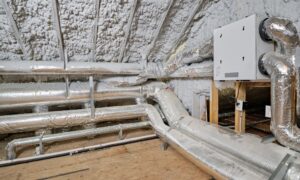
What You Need to Know About Rewiring an Old Home
Old homes have undeniable charm, but they often come with outdated electrical systems that may not meet modern safety standards or power demands. If you own or are planning to purchase an older home, rewiring is a crucial step in ensuring your property is both safe and functional. While the process can be complex and costly, upgrading your home’s wiring can prevent electrical hazards and improve overall energy efficiency.
In this guide, we’ll explore everything you need to know about rewiring an old home, from identifying outdated wiring to understanding the process and safety considerations.
1. Signs That Your Home Needs Rewiring
Before undertaking a full rewiring project, it’s essential to determine whether your home’s existing electrical system is outdated or unsafe. Some clear signs that rewiring is necessary include:
Frequent Electrical Issues
- Flickering or dimming lights: This can indicate overloaded circuits or poor wiring connections.
- Circuit breakers frequently tripping: If your breakers trip often when running multiple appliances, your wiring may not be able to handle modern power demands.
- Burning smells or discolored outlets: These are serious warning signs of potential electrical fires.
Outdated Wiring Types
Many older homes still contain knob-and-tube wiring (used in homes built before the 1950s) or aluminum wiring (common in homes from the 1960s and 1970s). These systems were not designed for modern appliances and can pose serious fire risks. If your home still has these wiring types, rewiring is strongly recommended.
Lack of Grounded Outlets
If your home has two-prong outlets instead of three-prong grounded outlets, it likely lacks proper grounding. Grounding is essential for preventing electrical shocks and protecting electronic devices from power surges.
2. Planning for a Rewiring Project
Hire a Licensed Electrician for an Inspection
Before starting any rewiring project, it’s best to hire a licensed electrician to conduct a thorough inspection. They will assess your current system, identify safety hazards, and recommend the best course of action.
Determine Your Electrical Needs
Modern homes require more power than older electrical systems were designed to handle. As part of the rewiring process, consider the following upgrades:
- Additional outlets: Avoid reliance on extension cords by adding outlets in key areas.
- Upgraded circuit capacity: Kitchens, bathrooms, and home offices require dedicated circuits for appliances and high-power devices.
- Smart home compatibility: If you plan to install smart lighting, security systems, or automation devices, ensure your electrical system supports these technologies.
3. Understanding the Rewiring Process
Replacing Old Wiring
Rewiring involves removing outdated electrical wiring and replacing it with modern, code-compliant wiring. This may require opening walls, ceilings, and floors to run new cables, making it a labor-intensive process.
Common wire types used in modern homes include:
- NM (non-metallic) cable: Used for general home wiring.
- MC (metal-clad) cable: Provides extra protection and is commonly used in exposed areas.
Updating Circuit Breakers and the Electrical Panel
During the rewiring process, circuit breakers play a crucial role in protecting your home from electrical overloads. Older homes may still have fuse boxes instead of modern breaker panels. While fuse boxes were effective in the past, they lack the safety features of modern circuit breakers, which automatically trip when a circuit is overloaded.
If your home still has an outdated fuse box or an undersized panel, upgrading to a 200-amp circuit breaker panel is highly recommended. This will allow your home to handle today’s power demands safely and efficiently.
4. Code Compliance and Safety Considerations
National Electrical Code (NEC) Standards
Rewiring an old home must comply with the National Electrical Code (NEC) and local building regulations. Some key requirements include:
- Ground Fault Circuit Interrupter (GFCI) outlets: Required in kitchens, bathrooms, garages, and outdoor areas.
- Arc Fault Circuit Interrupter (AFCI) protection: Helps prevent electrical fires by detecting dangerous arc faults.
- Proper wire sizing: Ensures that wires can handle the electrical load safely.
Permit and Inspection Requirements
Most jurisdictions require permits and inspections for major electrical work. A licensed electrician will ensure that your rewiring project is up to code and passes all necessary inspections.
5. Cost and Timeline for Rewiring
How Much Does Rewiring Cost?
The cost of rewiring an old home varies based on factors such as the home’s size, accessibility, and local labor rates. On average:
- Small homes (under 1,500 sq. ft.): $4,000 – $8,000
- Medium homes (1,500 – 3,000 sq. ft.): $8,000 – $15,000
- Large homes (3,000+ sq. ft.): $15,000 – $30,000
These estimates include labor, materials, and necessary panel upgrades.
How Long Does the Process Take?
Rewiring can take anywhere from a few days to several weeks, depending on the complexity of the project. If walls need to be opened, additional time will be required for repairs and refinishing.
6. Benefits of Rewiring Your Home
While rewiring an old home requires a significant investment, the benefits outweigh the costs:
1. Enhanced Safety
Modern wiring reduces the risk of electrical fires, shocks, and short circuits, keeping your home and family safe.
2. Improved Energy Efficiency
Older wiring is often inefficient and can lead to power loss. Upgrading to modern wiring helps reduce energy waste and can lower utility bills.
3. Increased Home Value
A newly rewired home is a major selling point for buyers. Homes with updated electrical systems often have higher property values and greater market appeal.
4. Better Compatibility with Modern Devices
From smart appliances to high-powered entertainment systems, modern homes require a reliable electrical infrastructure. Rewiring ensures that your home can support today’s technology without frequent power issues.
Final Thoughts
Rewiring an old home is a significant but necessary investment in safety, efficiency, and functionality. If your home still has outdated wiring, frequent electrical issues, or an undersized electrical panel, now is the time to consider an upgrade.
By working with a licensed electrician and ensuring that all work complies with electrical codes, you can modernize your home’s electrical system with confidence. Whether you’re restoring a historic property or simply bringing an aging home up to date, a well-planned rewiring project will provide peace of mind and long-term benefits for years to come.


